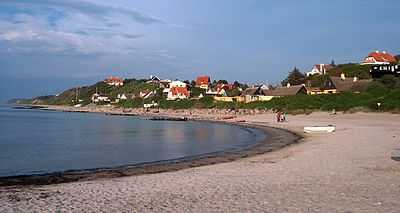Tisvilde

Tisvilde is a small town with a population of 1,537 (1 January 2014) [1] located on the north coast of the island Zealand (Sjælland) in Denmark 60 km (37 mi) in Gribskov Municipality, northeast of Hillerød.
Tisvildeleje is the coastal part of Tisvilde. "Leje" roughly translates as 'plain' and used to be a fishermans village. Now most of the fishermen's houses are used as charming summer residences. The southeast of Tisvilde is referred to as Tibirke.
Etymology
The name Tisvilde broken down to Tis-vilde, means "Ti's vælde" and have many interpretations. It can be understood as Where Tyr Reigns and the area is conceived as dedicated to the god Tyr in former ages. Ti is a common word for Tir (Týr) in Danish place names and can also mean God, without being specific about what God. "Væld" also means a spring and that spring is believed to be the spring known as Helene Spring nowadays. In addition "Væld" is also referring to the old Nordic word "ved" or "wald" meaning Forest. Tisvilde was previously covered by extensive oak woods, before the sand drifts began. So all in all, Tisvilde has three parallel meanings: Where Tyr Reigns, Tyrs Spring and Tyrs Forest.
The word Leje is used in several other place names in Denmark, such as Liseleje west of Tisvildeleje or Rågeleje and Gilleleje to the east.
Landmarks
Natural

Tisvilde Hegn
From around 1500, drifting sands began to bury the fields and farms around Tisvilde. The problem accelerated over the years and by 1700, most of the area had been deserted. Several attempts to counter the forces of nature, had been tried, but in 1724 the German Johan Ulrich Røhl was hired by the Crown and by help of the local peasants and 100 soldiers from Copenhagen, they managed to stop the dunes in the course of the 1730s, by covering them with seaweed and digging trenches. But while the dunes was successfully stopped in their march against civilisation, the sands had covered and transformed the countryside and made it completely barren. From around 1800 to 1900 this state was reversed, by planting the c. 1,300 ha forest[2] of Tisvilde Hegn in association with the plantations of Asserbo and Liseleje southwest. The first tree species to be planted was scots pine and later followed by spruce, birch, beech and oak. Tisvilde Hegn is the oldest plantation in Denmark[2] and now a Natura 2000 area, due to its rare habitat-types, flora and fauna and important birdlife.[3] Some of the species to be protected here is northern crested newt and large white-faced darter.[4]
The coastline at Tisvilde Hegn is known for its stretches of white, clean and child-friendly sandy beaches.[5]
Springs
- Helene Spring is one of Denmark's most famous springs, and legend has it that anyone whose illness has not responded successfully to other forms of treatment must come to the spring on 23 June (Sankt Hans Eve or Midsummer's Eve). Culturally, legend in Denmark has it that if one consumes a certain amount of water from its springs in the night and then stays at Saint Helene's grave until morning, he should be cured of all his sicknesses.[6]
-

Gnarled pine trees in Tisvilde Hegn
-

Coastal landscape at Tisvilde
-
The beach along Tisvilde Hegn.
-
The Helene Spring.
Manmade
- Tibirke Church was built on the site of an ancient "vi", a pre-Christian holy place. At the foot of the church near Bækkebrovej is a spring which may have been the place where pilgrims came in days of old. The church was originally the center of a small village with 10 farms, but they were all (including Tibirke Church) buried by drifting sand dunes and abandoned by order of the King in 1725.[5][7]
- Helene's Tomb is now a rectangular, grazed area surrounded by low stone fences. The two boulders leaning against each other indicate Helene's Tomb. It is located at Sankt Helenevej, 3220 Tisvildeleje.[8]
- Wieth-Knudsen Observatory built in 1959, is located in southern part of the town. The observatory is offering astronomical meetings open to the public, twice each month throughout the year.[9]
-

The Drifting Sands Monument in Tisvilde, raised in 1738. Texts in Danish, German and Latin.
-

Tibirke Church, once nearly covered by drifting sands.
-
Helenes's Tomb.
Events and activities
Being a popular summer destination for tourists, the level of activity is at its peak during the summer months. Examples are:
- Tisvilde flea market. Every Saturday throughout the summer a large, lively flea market (Tisvilde Loppemarked) is held in the Birkepladsen in front of Tisvildeleje station. The flea market is exclusively for private individuals, which means stalls full of unique finds from box-rooms and attics.[10]
- Musik i Lejet (English: Music in "Lejet"). An annual outdoor music festival held each summer.[11]
Literature
- Flemming Rune (2014): Tisvilde Hegn, Vol. 1, 2 and map-appendices, Forlaget Esrum Sø, ISBN 9788788393354. (Danish)
References
- ↑ "BEF44: Population 1st January, by urban areas" database from Statistics Denmark
- ↑ 2.0 2.1 Tisvilde Hegn Gyldendals Open Encyclopedia (Danish)
- ↑ Natura 2000 Actionplan proposal - Tisvilde Hegn and Melby Overdrev Danish Nature Agency (Danish)
- ↑ Tisvilde Hegn and Melby Overdrev (H119) Habitatarter.dk (Danish)
- ↑ 5.0 5.1 Tisvilde Hegn Danish Nature Agency. A map of the area. (Danish)
- ↑ "Tisvildeleje" (in Lingala). VisitDenmark. Retrieved 2013-02-12.
- ↑ "Tisvildeleje Travel Guide". Retrieved 2013-02-12.
- ↑ "historiske minder". Tisvilde.dk. Retrieved 2013-02-12.
- ↑ "Dr. N.P. Wieth-Knudsen Observatoriet". Astronomisk.dk. Retrieved 2013-02-12.
- ↑ Tisvilde Loppemarked
- ↑ "Musik i Lejet | Sommerens festival i Tisvildeleje". Musikilejet.dk. Retrieved 2013-02-12.
External links
| Wikimedia Commons has media related to Tisvilde. |
- Tisvilde Hegn Danish Nature Agency (Danish)
Coordinates: 56°03′08″N 12°05′05″E / 56.05222°N 12.08472°E


